Practice the problems of Math in Focus Grade 2 Workbook Answer Key Cumulative Review Chapters 7 to 9 to score better marks in the exam.
Math in Focus Grade 2 Cumulative Review Chapters 7 to 9 Answer Key
Concepts and Skills
Fill in the blank.
Question 1.
Which is longer, 3 meters or 5 meters? ___ m
Measure the pencils.
Then fill in the blanks.
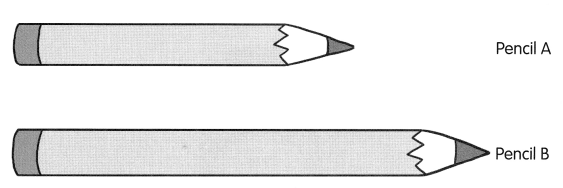
Answer: 5 meters is long.
A meter is a SI unit scientifically accepted as the base unit of distance and length. Along with other units like a kilometre or an inch, a meter is one of the fundamental units in SI. One meter equals the length of the path that a light travels in a vacuum for the time of 1/299,792,458 seconds. SI symbol for meter is m, and one meter is 100 centimetres or 1/1000th (10-3) of a kilometre.
5>3 so 5 metres is long.
Question 2.
Pencil A is ___ centimetres.
Answer: 300 centimetres.
Definition: Centimeter is considered a common unit of length used in SI. It is equivalent to 10 millimetres or 1/100th (10-2) of a meter. Years ago it was a basic unit in formerly used CGS (centimetre-gram-second) unit system, but in modern times the role of the basic unit of length is played by a meter. The symbol of centimetre is cm.
This is very easy to use a metre to centimetre converter. First of all, just type the meter (m) value in the text field of the conversion form to start converting m to cm, then select the decimals value and finally hit the convert button if auto calculation didn’t work. Centimetre value will be converted automatically as you type. The decimals value is the number of digits to be calculated or rounded of the result of meter to centimetre convert.
1 metre=100 centimetres.
Use the formula below to convert any value from meters to cm:
Centimetres=metres×100
To from meters to centimetres, you just need to multiply the value in meters by 100. (It is called the conversion factor)
Therefore, centimetres=3×100=300.
![]()
Question 3.
Pencil B is ___ centimetres.
Answer: 500 centimetres.
Explanation:
1 metre=100 centimetres.
Use the formula below to convert any value from meters to cm:
Centimetres=metres×100
To from meters to centimetres, you just need to multiply the value in meters by 100. (It is called the conversion factor)
Therefore, centimetres=5×100=500.

Question 4.
Which pencil is shorter? Pencil ______
Answer: Pencil A is shorter.
![]()
Because it is 300 cms which is lesser than pencil B.
Question 5.
How much shorter is it? ___ cm
Answer: 300 cms.
Pencil A is 300 cm shorter.
Draw. Then label.
Question 6.
Draw a line 7 centimetres long. Label it Line X.
__________
Answer:
– Construct a line L on a paper and mark A on it.
– Now place the metal point of the compass at the zero mark of the ruler.
– Make adjustments in the compass such that the pencil point is at the 7 cm mark on the ruler.
– Take compass on L such that its metal point is on A.
– Now mark a small mark as B on L which is corresponding to the pencil point of the compass.
– Here, AB is the required line segment of length 7 cm.
– The line is marked with X.

Question 7.
Draw a line 4- centimetres longer than Line X. Label it Line Y.
______________
Answer: 11 cm.
– Construct a line L on a paper and mark X on it.
– Now place the metal point of the compass at the zero mark of the ruler.
– Make adjustments in the compass such that the pencil point is at the 7 cm mark on the ruler and then mark 4 cms.
– Take compass on L such that its metal point is on X.
– Now mark a small mark as Y on L which is corresponding to the pencil point of the compass.
– Here, XY is the required line segment of length 11 cm.
– The line is marked with X and Y. And the total is 7+4=11 cm.

Fill in the blanks.
Question 8.
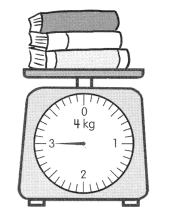
The books have a mass of ____ kilograms.
Answer: 3 kilograms.
Definition: kilogram (kg), the basic unit of mass in the metric system. A kilogram is very nearly equal (it was originally intended to be exactly equal) to the mass of 1,000 cubic cm of water. The pound is defined as equal to 0.45359237 kg, exactly. It is defined as being equal to the mass of the international prototype of the kilogram.
Explanation:
– It is showing the hand on 3.
– So it is 3 kgs.
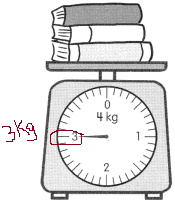
Question 9.
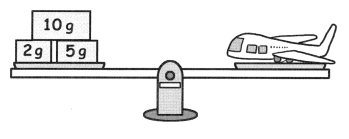
The toy aeroplane has a mass of ___ grams.
Answer: 17 grams.
Explanation:
The weights are 10, 2, 5.
Add all the grams to get total mass. 10+2+5=17 grams.
Therefore, the toy aeroplane has a mass of 17 grams.
Fill in the blanks.
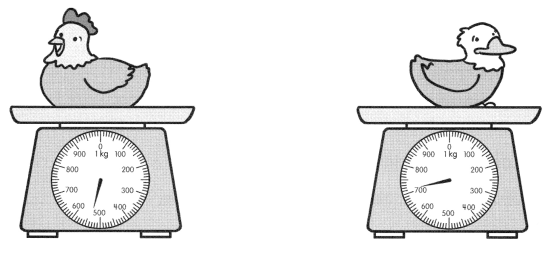
Question 10.
The chicken has a mass of ___ grams.
Answer: 550 grams.
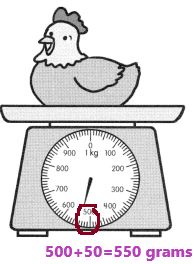
– The gram is a unit of mass.
– One gram is one-thousandth the mass of one kilogram. The previous definition of the gram was the absolute weight of a 1-centimetre cube of pure water at 4 °C.
– The symbol for the gram is g.
– The gram is a small unit of mass. It is approximately the mass of one small paper clip.
Explanation:
– The hand is showing on after 500. And the small measurements can be written as 10,20, 20, 40, 50, 60, 70, 80, 90, and 100.
– The hand is showing on 50. So it is 550 grams.(500+50=550).
Question 11.
The duck has a mass of ____ grams.
Answer: 710 grams.
– The gram is a unit of mass.
– One gram is one-thousandth the mass of one kilogram. The previous definition of the gram was the absolute weight of a 1-centimetre cube of pure water at 4 °C.
– The symbol for the gram is g.
– The gram is a small unit of mass. It is approximately the mass of one small paper clip.
Explanation:
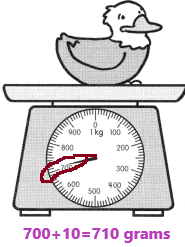
– The hand is showing on after 700. And the small measurements can be written as 10,20, 20, 40, 50, 60, 70, 80, 90, and 100.
– The hand is showing on 10. So it is 710 grams. (700+10=710).
Question 12.
Which is lighter? ____
Answer: Chicken.
Explanation:
The mass of chicken is 550 grams and the mass of duck is 710 grams. By comparing both grams chicken is lighter than duck because the weight of duck is more than chicken.
550<710.
Question 13.
How much lighter is it? ___ g
Answer:160 grams lighter.
Explanation:
By comparing both duck is having higher mass and the chicken is 550 gms.
To know how much lighter the chicken we need to subtract duck mass and chicken mass. Assume it as X.
X= 710-550
X=160 grams.
Fill in the blank.
Question 14.

What is the mass of the bag of rice? __ kg
Answer:7 kgs.
Definition: kilogram (kg), the basic unit of mass in the metric system. A kilogram is very nearly equal (it was originally intended to be exactly equal) to the mass of 1,000 cubic cm of water. The pound is defined as equal to 0.45359237 kg, exactly. It is defined as being equal to the mass of the international prototype of the kilogram.
Explanation:
How do I choose the bag of rice that is 7 kgs? I will explain below:

– Observe the 2nd picture, In that the total weight of potatoes are given.
– The weight of potatoes are 3kg+5kg=8kg.
– In the first picture, two different masses are there. Those are rice and potatoes.
– We already know the potatoes weight that is 8 kgs and the remaining 7 kgs are rice.
Look at the pictures. Then fill in the blank.
Question 15.

Containers A and B are the same size. Which container has a greater volume of water? Container ____
Answer: container B
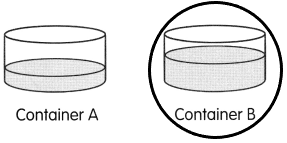
Observe the pictures carefully. Containers are equal but the water in them is different volumes. Container B is having more water than Container A. So I circles Container B.
Fill in the blanks.
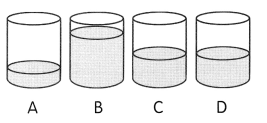
Containers A, B, C, and D are the same size.
Question 16.
Which container has the most water? Container ____
Answer: Container B.
Definition of volume:
– Volume is the number of shares of security traded during a given period of time.
– Generally, securities with more daily volume are more liquid than those without, since they are more “active”.
– Volume is an important indicator in technical analysis because it is used to measure the relative significance of a market move.
– The higher the volume during a price move, the more significant the move and the lower the volume during a price move, the less significant the move.
– Formula: Volume of cylinder=π · r2 · h
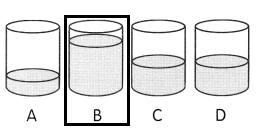
Observe the pictures carefully. Containers are equal but the water in them is different volumes. Container B is having more water than Container A, c, and D. So I circled the B container.
Question 17.
Container ___ contains the same amount as Container ____
Answer: C and D.
Container C and Container D have the same amount of water.
– If the water is in a cylindrical container, then the volume of that water is calculated using the formula to calculate the volume of the cylinder.
– If the water is only halfway high in the container, then you’ll need to use half the height of the cylinder in the formula.
Formula: Volume=π · r2 · h
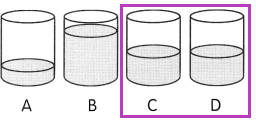
Find the volume of water in each container.
Example
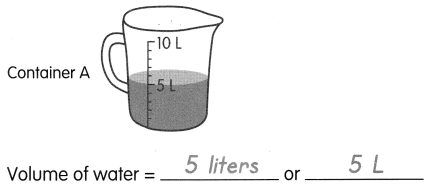
Question 18.
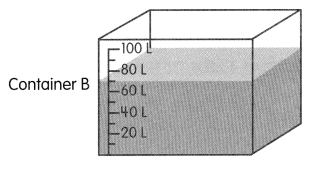
Volume of water = ___ or ____
Answer: 70 litres.
The volume of water is 70 litres or 70l.
Explanation:
– The volume of water is as good as the shape of the reservoir (container) it’s in. Often, the containers have a circular, rectangular or square cross-section.
– For a rectangular based container, we use the formula to calculate the volume of a rectangular prism also known as a cuboid.
– Formula: volume=l × b × h
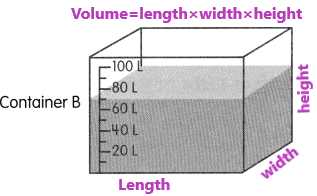
– The volume of water is 70 l and each litre difference in between them is 10.
Question 19.
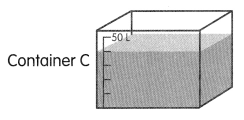
Volume of water = ___ or ____
Answer: 40 l
Explanation:
– The volume of water is as good as the shape of the reservoir (container) it’s in. Often, the containers have a circular, rectangular or square cross-section.
– For a rectangular based container, we use the formula to calculate the volume of a rectangular prism also known as a cuboid.
– Formula: volume=l × b × h
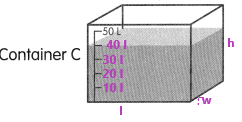
The volume of water is 40 litres or 40 l.
Question 20.
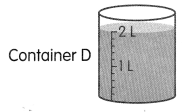
Volume of water = ___ or ____
Answer: 2 litres.
– If the water is in a cylindrical container, then the volume of that water is calculated using the formula to calculate the volume of the cylinder.
– If the water is only halfway high in the container, then you’ll need to use half the height of the cylinder in the formula.
Formula: Volume=π · r2 · h
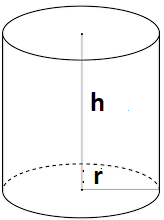
From the given question, the volume of water is 2 litres.
Fill in the blanks.
Use your answers for Exercises 18 to 20.
Question 21.
Which container has the greatest volume of water?
Container ____
Answer: Container B.
Explanation:
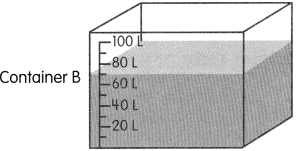
– For a rectangular based container, we use the formula to calculate the volume of a rectangular prism also known as a cuboid.
– Formula: volume=l × b × h
By comparing containers B, C, and D. Container D have the highest volume of water and is a cuboid in shape.
The volume of water is 70 litres.
Question 22.
Which container has the least volume of water?
Container ____
Answer: Container D.
– If the water is in a cylindrical container, then the volume of that water is calculated using the formula to calculate the volume of the cylinder.
– If the water is only halfway high in the container, then you’ll need to use half the height of the cylinder in the formula.
Formula: Volume=π · r2 · h

It has 2 litres of water which is least to compare all the containers.
Look at the pictures.
The containers are filled with water.
Which containers contain less than 1 liter of water each? Circle each answer.
Question 23.
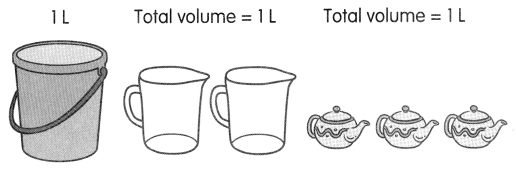
Answer:
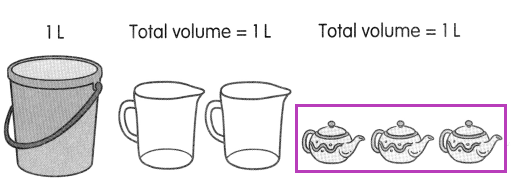
Explanation:
In the above picture, the last 3 cups will have less volume because 1 litre is divided into 3 parts. So the volume is less in those 3 cups.
Problem Solving
Solve.
Draw bar models to help you.
Question 24.
Mrs. Kim’s empty suitcase has a mass of 5 kilograms. After she packs some books into the suitcase, her suitcase has a mass of 21 kilograms. What is the mass of the books?
The mass of the books is ___ kilograms.
Answer: 16 kilograms.

The mass of empty suitcase=5 kgs
The mass of filled suitcase after packing books=21 kgs.
The mass of books=X
X=21-5
X=16 kgs.
Question 25.
Seth has a ball of string. He uses 35 centimetres of string to decorate his scrapbook. He uses another 78 centimetres of string to decorate a gift.
a. How much string does he use in all?
b. If he had 200 centimetres of string at first how much string does he have now?
a. He uses ___ centimetres of string in all.
b. He has ___ centimetres of string now.
Answer:
a. He uses 113 centimetres of string in all.
Explanation:
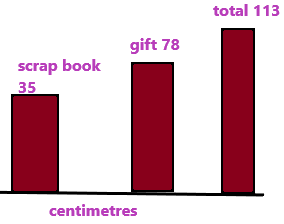
The number of cms he used string to decorate book=35
The number of cms he used string to decorate gift=78
The total string he used for decorating book and gift=X
Add both the cms to get the total cms of string.
X=35+78
X=113 cms.
b. He has 87 centimetres of string now.
Explanation:
The total string =113 cms
If he had 200 cms at first, now the string cms are how much?. Assume it as X.
Subtract supposed cms-actual cms. Then we get the answer.
X=200-113
X=87 cms.
Question 26.
Tania’s hand puppet has a mass of 440 grams. It is 120 grams heavier than Hector’s hand puppet. What is the total mass of the two hand puppets?
The total mass of the two hand puppets is ___ grams.
Answer: 1000 grams.
Explanation:
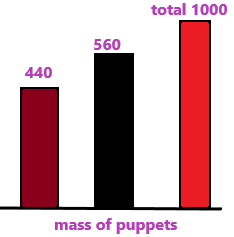
The mass of Hector’s hand puppet=440
The mass of Tania’s hand puppet which is 120 grams more than Hector’s hand puppet=440+120=560
The total mass of two hand puppets is 560+440=1000 grams.
Question 27.
A tank contains 65 litres of oil Another 15 litres of oil are added. Later, 40 litres are poured out. What is the volume of oil in the tank in the end?
The volume of oil in the tank, in the end, is ___ litres.
Answer: 40 litres.
Explanation:
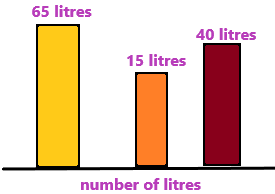
The number of litres of oil tank have=65
The number of litres added extra into the tank=15
The total number of litres of oil tank have after adding extra 15 litres=65+15=80
The number of litres poured out=40
The volume of the tank after pouring the 40 litres of oil=X
X=80-40
X=40 litres.
Question 28.
Sarah sells 27 liters of milk in the morning. She sells another 8 liters of milk in the afternoon. Ray sells 4-8 liters of milk.
a. Who sells more milk?
b. How much more?
a. ______ sells more milk.
b. sells ______ more litres of milk.
Explanation:
a. Sarah sells more milk.
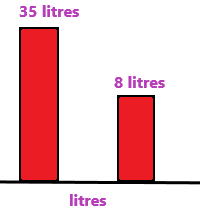
The number of litres she sells in the morning=27
The number of litres she sells in the afternoon=8
The total number of litres Sarah sells=27+8=35.
The number of litres Ray sells=4-8
By comparing both of them Sarah is selling 35 litres of milk which is more than Ray.
b. sells 27 more litres of milk.
Explanation:
The total number of litres Sarah sells=35
The maximum number of litres Ray sells is totally=8.
We need to calculate the number of more litres more Sarah is selling than Ray.
Subtract the total number of litres sold by Sarah – sold by Rey
=35-8
=27.
therefore, Sarah sells 27 litres more than Rey.
Try Once: